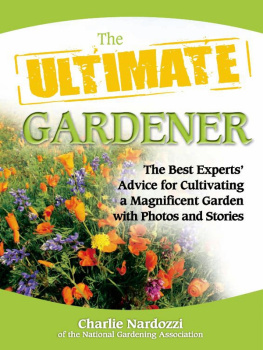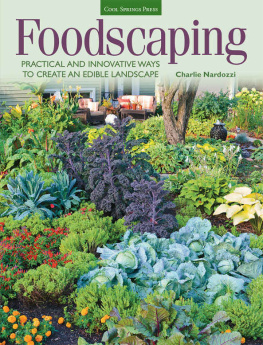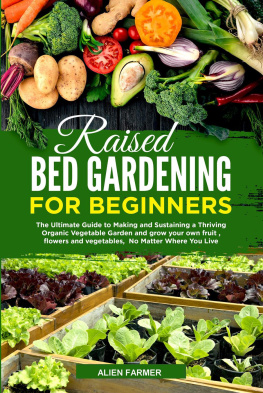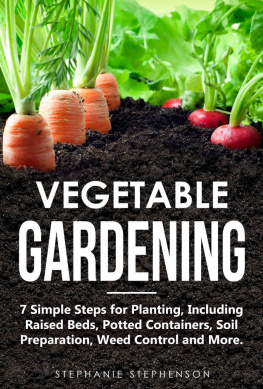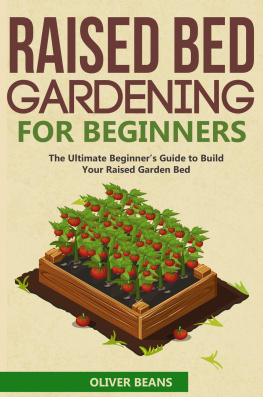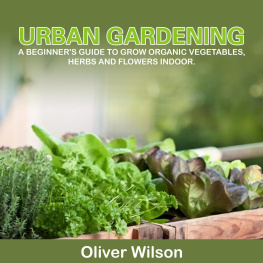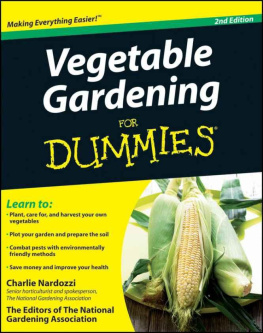Contents
Page List
Guide
Cover
The Complete Guide to
NO-DIG GARDENING
Grow beautiful vegetables, herbs, and flowersthe easy way!
Charlie Nardozzi
CONTENTS
INTRODUCTION:What is No-Dig Gardening?
Ever since humans went from hunters and gathers to farmers, weve been digging in the soil. At first, humans simply dug small holes in the ground to plant seeds with little disturbance of the native soils. But as humans evolved and required more and more food, farming and gardening techniques evolved as well. From human-powered cultivation to animal-powered digging to machine-driven tilling, weve continued to increase our digging, turning, and tilling of soils to produce food, flowers, and herbs. This hasnt come without consequences though. Soil erosion and degradation due to modern farming practices are major problems around the world.
But tides have shifted and attitudes have changed. In agriculture, no-till farming has proven a more productive way to grow large-scale crops while reducing erosion. In gardening, a similar approach has evolved over the last fifty years, inspired by gardeners and small-scale farmers worldwide. Gardeners and scientists are discovering the intricate life in the soil and the important role it plays in growing plants. No-dig gardening preserves and enhances that soil life, leading to more productive gardens. But the advantages of no-dig gardening go beyond caring for soil. Youll learn more about these advantages in .
This book is inspired by early no-dig pioneers and is dedicated to their work and the continuing work of so many other gardeners. While in university, I remember reading the classic One-Straw Revolution by Masanobu Fukuoka. This Japanese farmer discovered innovative ways to build the fertility of his land, such as growing daikon radishes and leaving them to decompose in the soil as a cover crop to break up compacted soils. In Australia, Esther Deans was starting her no-dig garden experiment with layers of newspaper, hay, straw, and compost because she had such heavy clay soil that traditional gardening was almost impossible. In the United States in the 1970s, Ruth Stout added to the body of no-dig knowledge with her deep-mulching techniques. She found simply by keeping a thick organic mulch cover on the soil year-round, she could easily plant without much weeding, watering, or fertilizing required. This made for a productive garden with less work.
Fast-forward to modern no-dig practitioners, such as Charles Dowding in England with his compost-rich no-dig system. Australian permaculturist Morag Gamble uses various layering techniques in her beds. American Toby Hemenway offers interesting ways to plant no-dig beds, such as the polyculture technique. The methods of no-dig vary around the world. Im highlighting some of the best in this book. Which methods you choose will depend on your location and situation.
No-dig gardens are productive and beautiful. They help preserve the soil life essential to our survival.
There are even variations on the traditional no-dig method that allow gardeners to grow where no garden has grown before. Straw bale gardening uses the organic matter in bales to grow a successful garden on walkways, driveways, and other impermeable surfaces. The Eastern European tradition of mound beds or hgelkultur is a great way to sequester carbon by burying logs and growing gardens on top of the pile. Keyhole gardening, as championed by gardeners such as Texan Deb Tolman, is being used to feed the world. Keyhole beds are popular in rural areas of Africa, where residents utilize organic materials found around villages to build productive and healthy home vegetable gardens. The work of these and many other no-dig gardeners is reflected in this book.
Recognizing that many gardeners dont have room to build even a small no-dig bed, Ive included information on container and indoor growing as well. You can use some of the same concepts inherent in no-dig gardening to grow healthy vegetables, flowers, and herbs in a container using compost-amended potting soils.
Most books start from a personal story, and this one is no exception. I started no-digging later in life. I was raised on my Italian grandfathers farm, and like most boys, I was enamored with tractors, trucks, plows, hay balers, and rakes. Our home garden was always tilled under in spring by my uncle with his tractor. It was just the way it was.
When I went to school to study horticulture, the benefits of tilling and digging were touted as necessary to grow plants well. It was only after school when I started researching various gardening methods, talking to other gardeners, experimenting in my own garden, and seeing demonstration beds that my thinking evolved to no-dig. While the benefits of less work and productive gardens were an enticement in those early days, now with global warming and the need to reduce carbon emissions at the forefront of many peoples minds, no-dig has taken on an added importance.
I hope this book inspires you to try no-dig gardening. Its a simple way to lessen our impact on the planet while growing our own food and flowers. With clear and practical steps, this hard-working book will be a reference for you in your garden for years to come. Lets begin by digging in (no pun intended) to why no-dig gardening is so beneficial.
Chapter 1
THE BENEFITS OF NO-DIG GARDENING
Among the many benefits of no-dig gardening is a more productive garden with less work.
Interest in gardening continues to grow around the world. More and more people crave contact with the natural world and want to feel more in control of their lives.
Growing a garden is a simple way to produce some of your own food and flowers, reduce stress and anxiety, and feel more connected to the natural world. But as interest in gardening grows, theres also a desire to make gardening less time-consuming, more productive, and more Earth-friendly. Thats why many gardeners are turning to the no-dig gardening method. No-dig gardening requires less work than traditional gardening practices, can be more productive, and helps sequester carbon, reducing global warming. No-dig gardening increases soil health and fertility, reduces weeding, watering, and fertilizing, and requires fewer outside inputs. Lets look at each of these benefits in more detail.
The Soil Wins
One of the basic tenets of no-dig gardening is similar to a medical doctors Hippocratic oathfirst, do no harm. The soil is teeming with seen and unseen life. Its estimated there are more bacteria, fungi, protozoa, and other creatures in one teaspoon (4.8 g) of soil than there are people on the planet! While it seems innocuous to dig or till your soil to create a garden, it actually is doing more harm than good. Digging and tilling destroys many of these microbes and the sensitive and intricate network of soil creatures, upsetting the balance of soil life underground. This destruction can lead to a temporary increase in release of nutrients for plants, but that effect soon diminishes. Not only is soil life destroyed, but organic matter (decaying plant and animal materialsmore on this later in the book) is decomposed at a faster rate, leading to the release of more carbon into the atmosphere. Tilling and digging also upsets the soil structure. Soil in tilled gardens can eventually become more compacted, with fewer air and water spaces.


